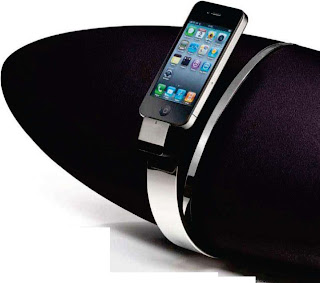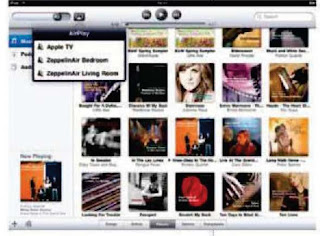
B8W's new dirigible is a stunner, but let down by AirPlay blackouts,
BY DAVE BULLARD
Stunning sound, design and build quality
— AirPlay prone to interference; pricey
www.ehifi.com.au
RRP $799
SCORE: 7
 The Zeppelin, Bowers & Wilkins' first foray into docking music systems four years ago, was a massive success. It won awards, garnered rave reviews and showed that you could get audiophiie sound from a (gasp!) iPod.
The Zeppelin, Bowers & Wilkins' first foray into docking music systems four years ago, was a massive success. It won awards, garnered rave reviews and showed that you could get audiophiie sound from a (gasp!) iPod.Now the Zeppelin Air has redefined the genre again by adding wireless support for Apple's AirPlay technology, which gives you the ability to play and control your iTunes library across your home network.
But that's not all. Though the Air looks much the same as the original airs hip-shaped Zep, it now features five drivers in a 2.1-channel configuration, each powered by a dedicated amp rated at 4 x 2SW and 1 x 50W.
Add tweaks such as improved digital signal processing (DSP) and 24-bit/96Khz DAC and the result is an amazing sound for a system of this size.
The audio is detailed and realistic, with each instrument sounding like it should. The high- and mid-ranges are nicely balanced and there's bags of floor-thumping bass.
And there's loads of power under the hood. The Zeppelin Air is almost like a high-performance car that reaches its peak power at 5000 revs, in that it seems to really hit its straps at higher volumes.
If the sound - particularly the bass - isn't to your liking, B&W provides instructions on tweaking the speaker settings on your iPhone or iPod.
All good so far, so what about its wireless AirPlay capabilities?
The Zeppelin Air can be set up for AirPlay by using a web-browser interface after either plugging it into your Mac or PC via an Ethernet cable or by activating and using the Air's own temporary wireless network.
After setup, the Zeppelin is available to any compatible device - computers running iTunes 10.1 or later, iPads, iPhones and iPod touches running iOS 4.2 or later - on the same network. More than one Zeppelin can be linked at a time.
AirPlay performance was mixed, with signal dropouts proving to be a problem. Initially these were frequent, even when trying the Air over several Wi-Fi networks and using both Macs and iOS devices as the sources.
A firmware update to Vl.1.3 got rid of the problem when streaming from Macs, but we still had problems with iOS devices running iOS 4.3. The audio would just stop streaming every couple of minutes, with the blackouts ranging from a second to half a minute.
Other reviewers have told us that in their experience AirPlay requires really robust Wi-Fi to avoid signal dropout, but our team had problems even when putting the Zeppelin right next to a Wi-Fi router with a maximum 802.Un signal.
However, the Australian distributors, Convoy International, used the unit after us and reported no problems.
That said, wireless audio quality was amazing. I played the same tracks over and over using both the dock and AirPlay, and struggled to hear a difference. If pushed, I would say that the latter suffered a very slight loss of clarity and sounded a tad warmer. It's definitely an improvement on Bluetooth.
When playing over AirPlay, your audio can be controlled on the source device itself, or via the Zeppelin's now-iconic pebble-shaped RF remote control,
I can't form any solid conclusions about the Zeppelin Air's AirPlay capabilities for two reasons: Convoy could just give us four days with the unit, and this is my first experience with an AirPlay-enabted speaker system.
But I can say that, overall, the Air is simply an exciting product... one of those rare beasts that gives you the warm glow of ownership.
If I was reviewing it as a straight iPod/iPhone speaker dock I'd give it a 9/10 rating. But its big selling point is its AirPlay capability, which lets it down due to the problems I experienced with interference. So I can't give it more than a 7.
Introduced in iTunes 10 on the Mac and PC,
and in iOS 4.2 on iPhone, iPad and iPod touch. Airplay is a revamp of Apple's old AirTunes technology ond allows users to stream audio, video and photos over a local network to devices like the Apple TV AirPort Express, and any third-porty hardware that licenses the technology from Apple
In addition to streaming media. Airplay also allows these devices to pull other metadata from iTunes including artist information, album art, and elapsed and remaining time Other brands joining Bowers & Wilkins in releasing AirRayenabled devices are iHorne, Denon, Marantz and Pioneer. And not only are they bringing out new, compatible devices but many of them are also issuing firmware upgrades that Pring AirPlay to older audio units, mainly home-theatre receivers.
AirPlay is a very clever technology with many uses. Say you're taking some home movies on your iPhone 4 you can simply navigate to that movie in the Photos app and stream the video and audio directly to your high-definition TV via the Apple TV
Or, if you have several AirPiay-enabled speakers dotted around your house -say, one r your bedroom, one in the office and one in the living room - you can stream the music from your Mac or PC to more than one room at the same time, so you get a never-ending music panorama as you walk around
AirPlay works over Wi-Fi or an Ethernet connection or a combination of botti. So you can stream music directly on your home network if you're near an Ethernet port or connect wirelessly if you're not. Some AirPiay-enabled devices don't have Wi-Fi connectivity, however, so be careful to check this when you're buying. Denon receivers, for example, only work with AirPlay over Ethernet, which Is a problem it you don't have a nearby Ethernet jack in your wall or it you don't want to run cables around your house.
Pioneer's soon-to-be-reieased AirPlay receivers are also Ethernet-only, but the company tells touch Ihere will be a wireless adaptor available.
Every AirPiay-enabled device has a different setup procedure, from hooking it up via Ethernet and running a browser-based interface to simply using an iOS app.
But, once set up, using Airplay is simplicity itself. When an AirPlay unit is detected on your local network, iTunes 10 or compatible iOS apps will display the AirPlay icon (which looks like a rectangle with a triangle pointing up into it). Tapping on this brings up a dropdown menu showing the host and AirPlay devices. Just touch or click on the one you want.
AirPlay works in the background, continuing to stream media remotely while you do other stuff.

No comments:
Post a Comment